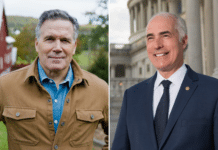
Can you smoke cannabis in state parks? How can you legally transport cannabis in your automobile without getting tagged for an “open container” violation? How will law enforcement officers determine whether someone they pull over has smoked marijuana and is too high to drive?
Lead officials for several public safety-related state agencies fielded a potpourri of questions at a press conference this week to announce a public relations campaign warning motorists that “driving high is a DWI.”
As Minnesotans prepare for adults aged 21 and older to be able to legally smoke marijuana starting at midnight on Tuesday, Aug. 1, the state Department of Public Safety is already launching a number of public awareness efforts to encourage people to refrain from using cannabis and then operating motor vehicles — be they cars on the road, boats on the water or ATVs and snowmobiles on the trails.
“If you choose to use cannabis please do so responsibly; never get behind the wheel after using drugs and alcohol,” said Bob Jacobson, DPS commissioner. “And always plan ahead for a sober ride, because if you feel different, you drive different.”
Even after the Aug. 1 enactment date of the new recreational cannabis law that Gov. Tim Walz signed in May, it will continue to remain a crime to drive while under the influence of cannabis, to consume the product while driving or to have an open container of the substance within reach of the driver or any passengers, said Col. Matt Langer of the Minnesota State Patrol.
“We want to get word out to drivers to not get behind the wheel if they choose to use cannabis or any other impairing substance,” Langer said at the Tuesday press conference that also featured comments from leadership at the Office of Traffic Safety and the Department of Natural Resources.
“Unfortunately, drugged driving is not new, our troopers and other law enforcement officers across the state have been recognizing a steady increase in drugged driving cases over the past several years,” Langer said.
“This is a big change for our state in a variety of areas, but when it comes to traffic safety it will never change our commitment to keep people safe on our roads,” Langer added.
Increase of ‘drugged driving’ over last decade
While “drugged driving” accounted for just under 7,000 DWI incidents between 2012 and 2016, the state saw that number increase to about 16,000 DWI incidents involving drugs from 2017 to 2021, representing a 127-percent increase over those two four-year periods.
“Just like with alcohol, if legalized cannabis is going to be part of the mix, then you need to make a safe, smart choice, plan a safe and sober ride home and stick to the plan,” said Mike Hanson, director of the state’s Office of Traffic Safety. “There are no excuses to end up in the back seat of a squad car, and ambulance or heaven forbid, a hearse.”
So how do law enforcement officers currently enforce “drugged driving” incidents across the state? There are a number of methods, Hanson said, including field observations and consultation with drug recognition evaluators (DRE) either on site or over the phone during a traffic stop where DWI is suspected, Hanson said.
One of the dozens of provisions included in the new recreational cannabis law that passed in the legislature this spring provides the state’s law enforcement with $10 million for DRE programs in 2024 and $5 million a year thereafter to support the education and training of law enforcement officers who make stops for drivers they suspect are under the influence of marijuana or other narcotics.
Such programming provides a “very scientifically scripted training course that allows [law enforcement officers] to evaluate somebody in a clinical way when they are under the influence of something other than alcohol,” said Hanson of the Office of Traffic Safety.
The new cannabis law also includes a provision to allow the Department of Public Safety to begin a pilot project that allows police officers and state troopers to utilize the latest oral fluid roadside testing to detect the presence of drugs in a person suspected of DWI. The program is voluntary, and the results of such tests will not be allowed in an evidentiary capacity, Hanson said.
More than 20 states across the nation utilize THC-detecting oral fluid testing technology in some capacity, Hanson said. DPS officials plan to begin the year-long pilot program in September and then provide the data and recommendations to the legislature on whether to utilize the technology in an official capacity moving forward.
“We want to use it as a screening test, just like we do with the [preliminary breath test], which tells us somebody is impaired and that alcohol is what is causing that impairment,” Hanson continued. “The oral fluid roadside test will be based on the officers’ observations, if they see the impairment and now they have a device that confirms the officers’ observations.”
Media members at the press conference took turns asking questions that sometimes appeared to stump officials on hand.
A journalist asked Rodman Smith, the Department of Natural Resources director of enforcement whether people will be allowed to smoke marijuana in state parks. And whether they can even smoke tobacco in state parks.
“I don’t smoke, so I guess I don’t know,” Smith told journalists. “I wasn’t prepared for state parks questions this morning — I apologize.”
Smith said DNR staff is working with its legal team to find a common approach to how it may enforce any regulations on cannabis consumption in state parks, if at all.
“We are working to find a common approach for all the state parks, rather than a patchwork,” he added.
Hank Long
Hank Long is a journalism and communications professional whose writing career includes coverage of the Minnesota legislature, city and county governments and the commercial real estate industry. Hank received his undergraduate degree at the University of Minnesota, where he studied journalism, and his law degree at the University of St. Thomas. The Minnesota native lives in the Twin Cities with his wife and four children. His dream is to be around when the Vikings win the Super Bowl.

















